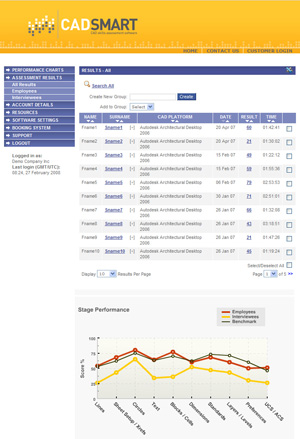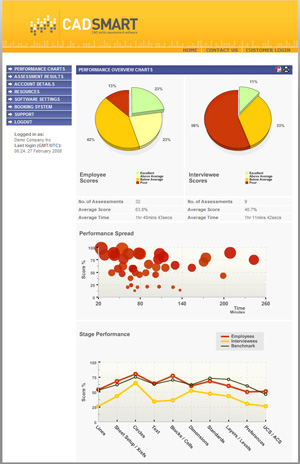A more targeted approach to benchmarking CAD skills for recruitment can give HR managers support in assessing the technical competence of candidates at interview stage, says Rory Vance, Managing Director, CADsmart.
Inefficient use of CAD technology in industry wastes millions of pounds each year. It is vitally important that HR teams in UK businesses have the tools to quantify the skills of new CAD members of staff, to make sure that they are right for the role in question, and that the role in question is right for them. Companies need to ensure the optimum performance of technical staff to deliver crucial workloads accurately in a highly pressurised environment.
Many companies today employ CAD technology on multiple projects at the same time, often across a number of offices, even across several locations worldwide. This, combined with the trend towards outsourcing and off-shoring of production information work, means it is vitally important to be able to benchmark the performance of teams using CAD software to maintain high standards.
It is essential that design and construction firms are able to quantify the performance of CAD teams, particularly when recruiting new staff. More enlightened firms are responding to this need by implementing a roadmap to enable a better return on their considerable investment in CAD technology.
At the same time, HR teams need clear direction on how to improve CAD operative standards. Until recently, lack of quality information relating to CAD productivity and performance has meant that HR teams have not been able to develop appropriate training plans, and develop a more strategic and accurate approach to recruitment, resourcing, new staff inductions, software upgrades and annual appraisals.
Although CAD has been used on projects for more than 15 years, the construction industry has never really had a formula or suitable metrics in place to monitor and benchmark the efficiency with which this technology is being used. Often, due to project pressure, and a lack of an industry standard for CAD, recruiters have relied upon references, or trusting that a candidateÝs CV and portfolio really are a true representation of his or her CAD ability. Inevitably, this is not always the case. This hit and miss approach to hiring new staff can prove costly.
Both HR and CAD managers can benefit from a clearer understanding of an individualÝs ability to use CAD software. Communication between HR management and IT management can be improved with better visibility of each individual candidateÝs core skills.
When planning CAD training and development programmes, it is important to consider each user and the typical circumstances in which CAD is used during the course of their work. Some may be full-time users, while others may only use the tool occasionally.
CAD training and resourcing in the construction industry
The following data illustrate companiesÝ attitudes to CAD training and resourcing in the construction industry:
´ 20 per cent of companies do not set any money aside for training;
´ 56.3 per cent of companies have an official company training policy;
´ only 18.8 per cent have a structured CAD training scheme;
´ 16.3 per cent of companies rely on the users to request training and 32.5 per cent rely on logged support calls to form CAD training content, while 32.5 per cent of companies rely solely on their CAD manager to decide on training content;
´ 78.8 per cent of CAD managers are responsible for providing internal training;
´ an average of 44.5 per cent of a companyÝs training budget is spent on CAD training;
´ 60 per cent of practices test the CAD ability of interview candidates;
´ 80 per cent induct CAD staff once they have started work;
´ 25 per cent always prefer to send their staff out for CAD training;
´ 15 per cent never send their staff on external CAD training;
´ 75 per cent prefer their training to be bespoke;
´ 67 per cent of firms state lack of time/resources as a reason for not sending people out to CAD training courses.
(Source: Evolve Consultancy CAD ManagerÝs Survey 2007; data based on responses from 128 registered UK architectural, engineering and construction firms. www.evolve-consultancy.com)
A project running in the UK construction industry since 2003 has captured the results of more than 6,000 individual CAD skills assessments, all taken using CADsmart independent testing software. The results comprise a national CAD benchmark – a standard against which companies can compare their own staff CAD performance – and have set meaningful targets for improvement.
?It is estimated that a staggering 75 per cent of the UK construction industryÝs working drawings produced during the design stage are created using CAD software. In a sector estimated to make up about 10 per cent of UK gross domestic product, approaching ú95 billion each year, the fact that so many firms are dependent upon the accuracy and efficiency of their CAD operatives is significant.
Missed deadlines, project reworking, problems on site caused by inaccurate drawings – a host of issues can lead to construction projects experiencing delays during build phase, which could easily have been avoided with better working practices at the design stage. The consequences of inaccurate drawings can be significant, not only in terms of the knock-on effect across the entire project, but also financially technical errors and slow delivery of drawings can have an immediate impact upon the projectÝs financial profits and ultimately the bottom line of the entire company.
Architects, civil engineers, structural engineers, technologists, building-services engineers, technicians, surveyors, landscape designers, house builders and contractors each use CAD in a distinctly different way. Tailoring training and development plans to reflect these individual needs is not only more effective, but costs less, too.
Typically, when planning CAD training courses, the industry has a habit of spending its budget on non-tailored, ýoff the shelf¯ style courses or software-upgrade modules from vendors and resellers. This does not always provide the best return on investment, as seldom does the course content apply to their staffÝs individual needs or project types.
By mapping the training courses to gaps in each userÝs knowledge, and by using a mix of in-house resources and formal external training, the learning environment is much more relevant, and results are demonstrably better.
The options available for improvement
Companies identifying individual user ability and experience using CAD can consider a range of options:
´ appoint a CAD reseller or preferred training partner to conduct one-to-one interviews with staff to gauge their level of CAD experience;
´ task the CAD management team with developing an in-house ýCAD test¯ for existing teams and new recruits;
´ appoint a preferred recruitment agency to quantify CAD knowledge during initial candidate interview and to reference check the CAD credentials of potential new starters;
´ investigate more formal examinations, such as C&G (City & Guilds) 2D and 3D CAD, CAD vendor certification exams post-training, or the ECDL (European Computer Driving Licence) 2D CAD course;
´ search the web for a ýmulti-choice¯ question-type assessment that captures individual CAD knowledge;
´ use a CAD skills-assessment software package ± such as CADsmart ± to benchmark CAD teams and feed performance data into more targeted training and recruitment programmes.
The advantages of the assessment-software approach

A number of engineering consultancies, architectural practices and local authorities are adopting the assessment-software approach to help to measure and improve CAD productivity. The results of every assessment allow each organization to access, sort and analyze the data and then apply the outcomes to the business.
The assessment data feeds into specific, targeted training programmes and workshops for AutoCAD and Microstation, the two most commonly used CAD software products in the UK. The data can also benefit firms when used as part of a structured recruitment process.
A couple of case studies
Benoy is an international firm of award-winning architects, masterplanners, interior and graphic designers working from offices in the UK, Middle and Far East. The company has a dynamic and well-managed CAD team that mainly uses Autodesk software for the production of information and detailing work. The practice has been using CADsmart since 2004, to help to monitor CAD development.
Associate director Paul Carnell observed: ýCADsmart allows us accurately to understand the skills base of our current and prospective colleagues and enables the continuous development and maintenance of high-level CAD standards within our practice.¯
WSP Group plc is a global business providing design, engineering, management and consultancy services to the built and natural environment. WSP has around 8,000 staff operating from more than 100 offices in Africa, Asia, Europe, the Middle East, north America and Oceania. WSP has a large CAD resource, using Autodesk and Bentley software for its production information and detailing work. The practice has been using CADsmart since 2006, to help to maintain a high level of CAD productivity between the groupÝs offices.
David Hoole, UK CAD improvement manager, explained: ýCADsmart has proved to be a valuable tool in increasing visibility and understanding of our large and diverse CAD user-base. The individual assessments combine to allow us to develop targeted training programmes, making efficient use of our resources. In addition to training needs analysis, CADsmart assessment also forms part of our recruitment process, helping to provide a more objective view of potential employees.¯
Great scope for productivity gains
To highlight the risks of recruiting unknown CAD personnel, a six-month live exercise was carried out across nine UK firms of engineering and architectural practices. During this time the basic CAD skills of 85 recruits were assessed at interview.
Accuracy scores achieved by those taking the exercise ranged from 5 per cent to 95 per cent. The time the candidates took to complete the assessment ranged from 26 minutes to over four hours. This demonstrates the broad range of basic CAD skills in todayÝs marketplace. Once a company knows what people can and cannot do with CAD, the firm can both provide a more valuable induction process for new recruits, and know with confidence where to place new starters within the organization.
The research has shown that, by targeting simple performance improvements each year, companies can make significant productivity gains.
Take an average salary of ú25k p.a. and a 225-day working year.
For every 1 per cent improvement in productivity, a practice could save ú250, or 2.25 days per person per year.
A target of 5 per cent annual improvement in performance is worth ú1,250, or 11.25 days per person per year. Remember that 11.25 days is the equivalent to 90 working hours, based on an average eight-hour working day.
All of this means that a company with 20 staff could be seeing a saving that is worth the equivalent of a new member of staff (20 x ú1,250 = ú25,000).
Improving the visibility of the CAD ability of incoming staff can save money and time.
Employing inappropriate personnel for three months can be expensive. Consider the following:
Permanent:
Assuming a ú25k annual salary:
15 per cent agency fee = ú3,750
3 monthsÝ salary = ú6,250
Contract:
Assuming ú18/hr:
7.5 hrs x 5 days = ú675 x 12 weeks = ú8,100
These examples do not include advertising costs for staff employed directly, or the cost of reworking for drawings that were not done right first time.
Industry Best Practice Leading industry influencers are now promoting best practice for CAD performance improvement. These include the IT Construction Forum, Construct I.T., ACE and ICE. www.constructingexcellence.org.uk www.construct-it.org.uk www.acenet.co.uk www.ice.org.uk






